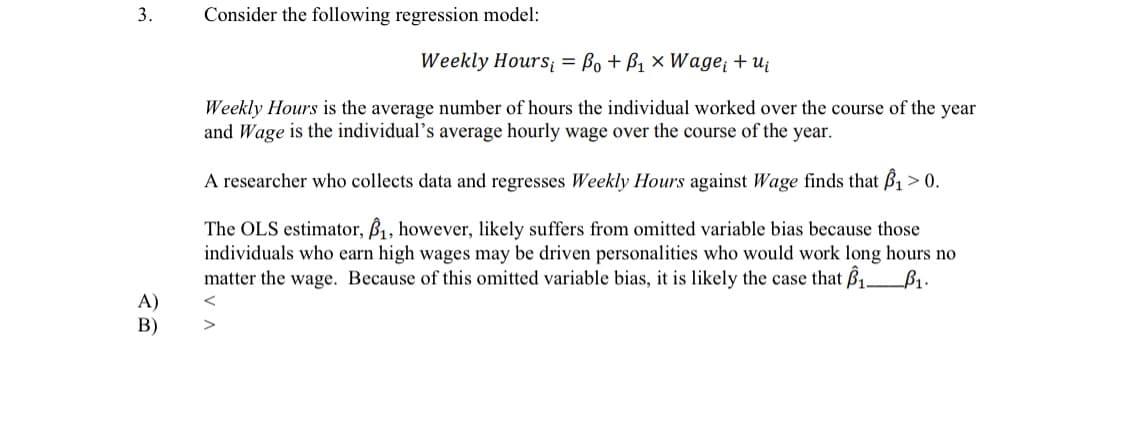Consider the following regression model: Weekly Hours = Bo + B1 × Wage + uį Weekly Hours is the average number of hours the individual worked over the course of the ye and Wage is the individual's average hourly wage over the course of the year. A researcher who collects data and regresses Weekly Hours against Wage finds that B1> 0. The OLS estimator, B1, however, likely suffers from omitted variable bias because those individuals who earn high wages may be driven personalities who would work long hours no matter the wage. Because of this omitted variable bias, it is likely the case that ß1 B1.
Consider the following regression model: Weekly Hours = Bo + B1 × Wage + uį Weekly Hours is the average number of hours the individual worked over the course of the ye and Wage is the individual's average hourly wage over the course of the year. A researcher who collects data and regresses Weekly Hours against Wage finds that B1> 0. The OLS estimator, B1, however, likely suffers from omitted variable bias because those individuals who earn high wages may be driven personalities who would work long hours no matter the wage. Because of this omitted variable bias, it is likely the case that ß1 B1.
Linear Algebra: A Modern Introduction
4th Edition
ISBN:9781285463247
Author:David Poole
Publisher:David Poole
Chapter7: Distance And Approximation
Section7.3: Least Squares Approximation
Problem 31EQ
Related questions
Question

Transcribed Image Text:3.
Consider the following regression model:
Weekly Hours = Bo + B1 × Wage + uj
Weekly Hours is the average number of hours the individual worked over the course of the year
and Wage is the individual's average hourly wage over the course of the year.
A researcher who collects data and regresses Weekly Hours against Wage finds that B1 > 0.
The OLS estimator, B, however, likely suffers from omitted variable bias because those
individuals who earn high wages may be driven personalities who would work long hours no
matter the wage. Because of this omitted variable bias, it is likely the case that B1_B1.
A)
В)
Expert Solution
This question has been solved!
Explore an expertly crafted, step-by-step solution for a thorough understanding of key concepts.
Step by step
Solved in 2 steps

Recommended textbooks for you

Linear Algebra: A Modern Introduction
Algebra
ISBN:
9781285463247
Author:
David Poole
Publisher:
Cengage Learning

College Algebra
Algebra
ISBN:
9781305115545
Author:
James Stewart, Lothar Redlin, Saleem Watson
Publisher:
Cengage Learning

Linear Algebra: A Modern Introduction
Algebra
ISBN:
9781285463247
Author:
David Poole
Publisher:
Cengage Learning

College Algebra
Algebra
ISBN:
9781305115545
Author:
James Stewart, Lothar Redlin, Saleem Watson
Publisher:
Cengage Learning